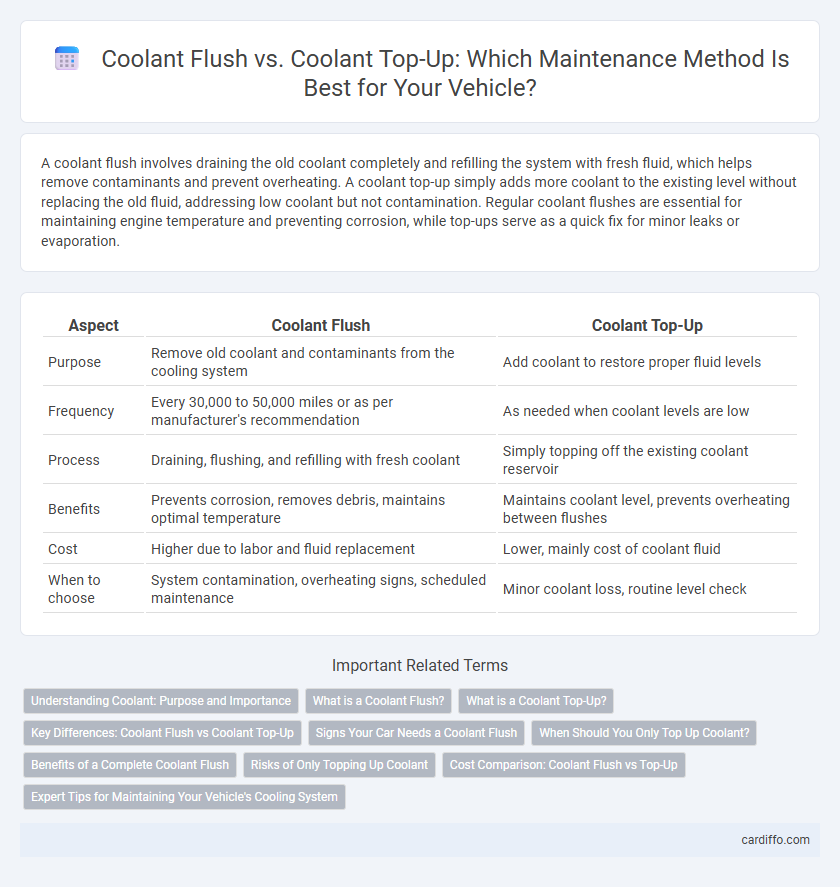A coolant flush involves draining the old coolant completely and refilling the system with fresh fluid, which helps remove contaminants and prevent overheating. A coolant top-up simply adds more coolant to the existing level without replacing the old fluid, addressing low coolant but not contamination. Regular coolant flushes are essential for maintaining engine temperature and preventing corrosion, while top-ups serve as a quick fix for minor leaks or evaporation.
Table of Comparison
| Aspect | Coolant Flush | Coolant Top-Up |
|---|---|---|
| Purpose | Remove old coolant and contaminants from the cooling system | Add coolant to restore proper fluid levels |
| Frequency | Every 30,000 to 50,000 miles or as per manufacturer's recommendation | As needed when coolant levels are low |
| Process | Draining, flushing, and refilling with fresh coolant | Simply topping off the existing coolant reservoir |
| Benefits | Prevents corrosion, removes debris, maintains optimal temperature | Maintains coolant level, prevents overheating between flushes |
| Cost | Higher due to labor and fluid replacement | Lower, mainly cost of coolant fluid |
| When to choose | System contamination, overheating signs, scheduled maintenance | Minor coolant loss, routine level check |
Understanding Coolant: Purpose and Importance
Coolant plays a crucial role in regulating engine temperature and preventing overheating by absorbing and dissipating heat efficiently. A coolant flush completely replaces old coolant, removing contaminants and buildup that can impair system performance, whereas a coolant top-up simply restores the coolant level without addressing potential degradation. Regular maintenance through coolant flushes ensures optimal engine protection, extends radiator and water pump life, and maintains vehicle reliability.
What is a Coolant Flush?
A coolant flush is a thorough maintenance procedure that involves draining the old coolant from the vehicle's cooling system and replacing it with fresh antifreeze to remove contaminants and prevent corrosion. This process helps maintain optimal engine temperature, prevents overheating, and extends the lifespan of the radiator, water pump, and thermostat. Regular coolant flushes are essential for vehicles with high mileage or those exposed to extreme driving conditions.
What is a Coolant Top-Up?
A coolant top-up involves adding a small amount of coolant to the vehicle's existing coolant system to maintain optimal fluid levels and prevent overheating. This process addresses minor coolant loss caused by evaporation or small leaks without fully draining the system. Regular coolant top-ups help sustain engine temperature regulation and protect against corrosion within the cooling system.
Key Differences: Coolant Flush vs Coolant Top-Up
Coolant flush involves completely draining and replacing the old coolant to remove contaminants and prevent corrosion, while coolant top-up simply adds fresh coolant to maintain the proper fluid level. A flush is typically recommended every 30,000 to 50,000 miles or as specified by the vehicle manufacturer, ensuring optimal engine cooling performance. Top-up is a quicker, interim solution that addresses minor coolant loss but does not eliminate sludge or buildup within the cooling system.
Signs Your Car Needs a Coolant Flush
Frequent engine overheating, persistent coolant leaks, and a noticeable sweet smell inside the cabin are clear signs your car needs a coolant flush rather than a simple coolant top-up. Rust-colored or dirty coolant visible in the reservoir indicates contamination that reduces cooling efficiency and can lead to engine damage. Regular flushing removes debris, rust, and old coolant residues, ensuring optimal engine temperature regulation and preventing costly repairs.
When Should You Only Top Up Coolant?
Only top up coolant when the fluid level is slightly low but the coolant quality remains stable, free of discoloration or debris, and there are no signs of leaks in the cooling system. Regular coolant top-ups are recommended between scheduled coolant flushes, typically every 25,000 to 50,000 miles, depending on the vehicle manufacturer's guidelines. If the coolant is contaminated, rusty, or the system has been overheated, a full coolant flush is necessary to prevent engine overheating and corrosion.
Benefits of a Complete Coolant Flush
A complete coolant flush removes all old coolant, contaminants, and rust deposits from the vehicle's cooling system, ensuring optimal engine temperature regulation and preventing overheating. This process improves heat transfer efficiency, extends the lifespan of coolant hoses and the radiator, and reduces the risk of corrosion and internal damage. Regular flushes maintain engine performance and prevent costly repairs compared to simple coolant top-ups that only add coolant without addressing underlying system contamination.
Risks of Only Topping Up Coolant
Only topping up coolant without performing a full coolant flush risks mixing old and new fluids, reducing the coolant's effectiveness and causing potential engine overheating. Accumulated contaminants and corrosion in the cooling system remain unaddressed, leading to possible radiator blockages and water pump failure. Over time, this can result in costly engine damage and compromised vehicle performance.
Cost Comparison: Coolant Flush vs Top-Up
A coolant flush typically costs between $100 and $150 due to the labor-intensive process of draining, cleaning, and refilling the entire coolant system, whereas a coolant top-up usually ranges from $20 to $50 as it only involves adding coolant to the existing system. Choosing a coolant flush can prevent future costly repairs by removing contaminants and maintaining optimal engine temperature, while a top-up is more cost-effective for addressing minor coolant level drops. The long-term savings from a flush often outweigh the initial higher cost compared to repeated top-ups that may mask underlying cooling system issues.
Expert Tips for Maintaining Your Vehicle's Cooling System
Regular coolant flushes remove corrosion, contaminants, and old coolant, preventing overheating and extending engine life. Coolant top-ups temporarily maintain proper fluid levels but do not address system contamination or deterioration. Experts recommend flushing the cooling system every 30,000 to 50,000 miles to optimize heat transfer and prevent costly repairs.
Coolant Flush vs Coolant Top-Up Infographic

 cardiffo.com
cardiffo.com